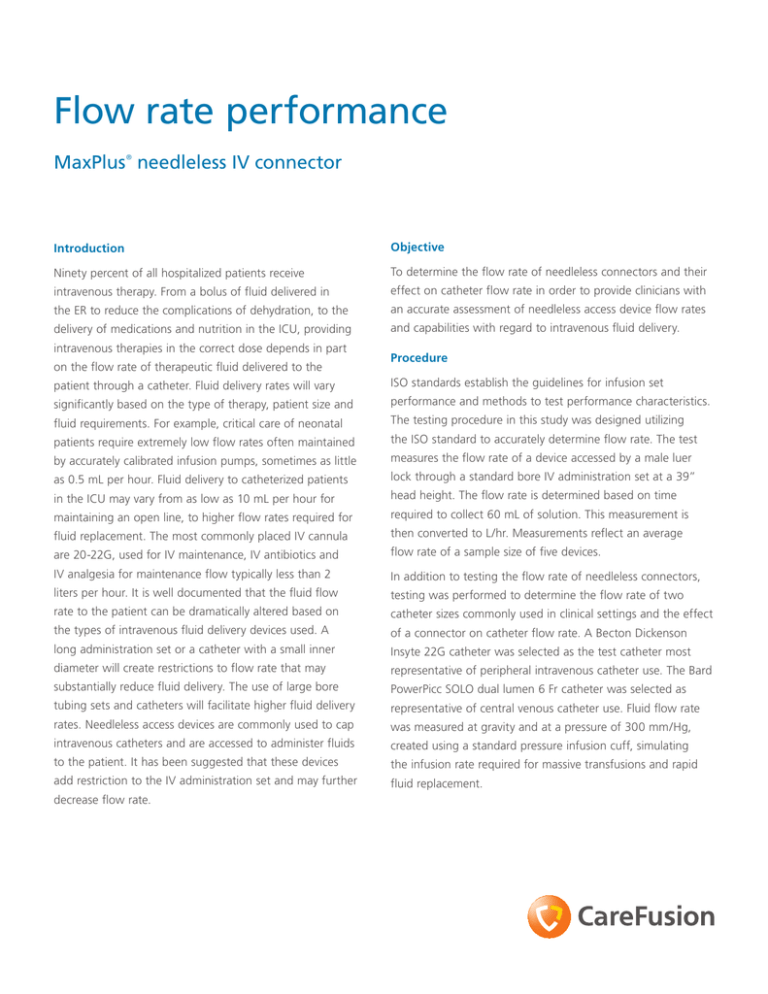
Flow rate performance
MaxPlus needleless IV connector
®
Introduction
Objective
Ninety percent of all hospitalized patients receive
To determine the flow rate of needleless connectors and their
intravenous therapy. From a bolus of fluid delivered in
effect on catheter flow rate in order to provide clinicians with
the ER to reduce the complications of dehydration, to the
an accurate assessment of needleless access device flow rates
delivery of medications and nutrition in the ICU, providing
and capabilities with regard to intravenous fluid delivery.
intravenous therapies in the correct dose depends in part
on the flow rate of therapeutic fluid delivered to the
Procedure
patient through a catheter. Fluid delivery rates will vary
ISO standards establish the guidelines for infusion set
significantly based on the type of therapy, patient size and
performance and methods to test performance characteristics.
fluid requirements. For example, critical care of neonatal
The testing procedure in this study was designed utilizing
patients require extremely low flow rates often maintained
the ISO standard to accurately determine flow rate. The test
by accurately calibrated infusion pumps, sometimes as little
measures the flow rate of a device accessed by a male luer
as 0.5 mL per hour. Fluid delivery to catheterized patients
lock through a standard bore IV administration set at a 39”
in the ICU may vary from as low as 10 mL per hour for
head height. The flow rate is determined based on time
maintaining an open line, to higher flow rates required for
required to collect 60 mL of solution. This measurement is
fluid replacement. The most commonly placed IV cannula
then converted to L/hr. Measurements reflect an average
are 20­-22G, used for IV maintenance, IV antibiotics and
flow rate of a sample size of five devices.
IV analgesia for maintenance flow typically less than 2
In addition to testing the flow rate of needleless connectors,
liters per hour. It is well documented that the fluid flow
testing was performed to determine the flow rate of two
rate to the patient can be dramatically altered based on
catheter sizes commonly used in clinical settings and the effect
the types of intravenous fluid delivery devices used. A
of a connector on catheter flow rate. A Becton Dickenson
long administration set or a catheter with a small inner
Insyte 22G catheter was selected as the test catheter most
diameter will create restrictions to flow rate that may
representative of peripheral intravenous catheter use. The Bard
substantially reduce fluid delivery. The use of large bore
PowerPicc SOLO dual lumen 6 Fr catheter was selected as
tubing sets and catheters will facilitate higher fluid delivery
representative of central venous catheter use. Fluid flow rate
rates. Needleless access devices are commonly used to cap
was measured at gravity and at a pressure of 300 mm/Hg,
intravenous catheters and are accessed to administer fluids
created using a standard pressure infusion cuff, simulating to the patient. It has been suggested that these devices
the infusion rate required for massive transfusions and rapid
add restriction to the IV administration set and may further
fluid replacement.
decrease flow rate.
Test results discussion
Gravity flow rate in liters per hour
Connector type
Flow rate
through
admin set
Flow rate
through
admin set
& catheter
Δ From
catheter
Flow rate
through
admin set
catheter &
connector
Δ From
needleless
connector
Needleless
connector
effect on
flow rate
connectors in most cases do not significantly impact fluid
flow rate through the catheter. The variable exerting the
Results Bard PowerPicc 6 Fr
MaxPlus clear
connector
The results in the preceding tables illustrate that needleless
most impact on flow rate is the catheter itself, which causes
16.65
0.86
-15.79
0.87
+0.05%
Insignificant
A
16.65
0.86
-15.79
0.83
-0.15%
Insignificant
rate of a simulated IV administration set.
B
16.65
0.86
-15.79
0.85
-0.12%
Insignificant
The MaxPlus needleless connector delivers a flow rate of
C
16.65
0.86
-15.79
0.86
0
Insignificant
219 mL/hr, equivalent to a 14G catheter,1 which is substantially
D
16.65
0.86
-15.79
0.85
-0.11%
Insignificant
E
16.65
0.86
-15.79
0.88
+0.16%
Insignificant
F
16.65
0.86
-15.79
0.85
-0.10%
Insignificant
Results BD InSyte 22G
restriction to fluid delivery when compared to the free flow
higher than most other connector designs. One study found
that a 140 mL/min flow rate was sufficient to stabilize most
patients in trauma situations requiring massive transfusions.2
Common practice in trauma cases is to establish two patient IV
lines, or to insert a large catheter into a large vein and connect
MaxPlus clear
connector
16.65
3.66
-12.99
3.66
0
Insignificant
the administration set directly to the catheter hub in order to
A
16.65
3.66
-12.99
3.45
-0.14%
Insignificant
B
16.65
3.66
-12.99
3.33
-0.22%
Insignificant
establish a high rate of infusion. Trauma requirements such
C
16.65
3.66
-12.99
3.67
+0.13%
Insignificant
D
16.65
3.66
-12.99
3.07
-4.65%
Insignificant
E
16.65
3.66
-12.99
3.54
-0.92%
Insignificant
F
16.65
3.66
-12.99
3.23
-0.28%
Insignificant
as these are infrequent, far outnumbered by more common
intravenous delivery requiring lower administration rates.
300 mm/Hg flow rate in liters per hour
MaxPlus clear
connector
25.44
3.05
-22.39
3.09
+0.19%
Insignificant
A
25.44
3.05
-22.39
3.04
-0.01%
Insignificant
B
25.44
3.05
-22.39
3.00
-0.20%
Insignificant
C
25.44
3.05
-22.39
3.05
+0.04%
Insignificant
D
25.44
3.05
-22.39
2.95
-0.33%
Insignificant
E
25.44
3.05
-22.39
3.07
+0.13%
Insignificant
F
25.44
3.05
-22.39
2.98
-0.22%
Insignificant
25.44
A
4.97
19.74
E
7.4
10.68
D
7.76
15.63
B
3.57
16.34
A
Results BD InSyte 22G
MaxPlus clear
connector
10.02
F
Results Bard PowerPicc 6 Fr
7.71
-18.34
7.65
-2.28%
Insignificant
25.44
7.71
-18.34
7.38
-2.83%
Insignificant
B
25.44
7.71
-18.34
7.12
-4.36%
Insignificant
C
25.44
7.71
-18.34
7.88
+1.29%
Insignificant
D
25.44
7.71
-18.34
6.20
-8.09%
Decreased
flow rate
E
25.44
7.71
-18.34
7.70
-0.58%
Insignificant
F
25.44
7.71
-18.34
6.53
-5.99%
Decreased
flow rate
7.44
10.68
MaxPlus
11
0
5
10
15
20
300 mm/Hg
Gravity
Flow rates measured through standard bore administration set with
needleless access connector attached
Conclusion
The MaxPlus needleless connector accommodates a
References
1 Iserson, Kenneth V., et al. Comparison of Flow Rates for Standard and Large-Bore Blood
Tubing. The Western Journal of Medicine, August 1985; 143(2):183-185.
comprehensive range of intravenous administration
requirements and is suited to virtually all clinical applications.
2 Rieger, Armin, et al, Safe and Normothermic Massive Transfusions by Modification of an
Infusion Warming and Pressure Device. Journal of Trauma-Injury Infection and Critical Care,
October 1995; 39(4):686-688.
From the low fluid requirements of neonatal and KVO (“keep
Data on file at CareFusion.
delivery, the MaxPlus clear connector can facilitate optimal
© 2011 CareFusion Corporation or one of its subsidiaries. All rights reserved. MaxPlus is a
trademark or registered trademark of CareFusion Corporation or one of its subsidiaries. All
other trademarks are property of their respective owners. U.S. Patent: 5,730,418. MX2924
(1011/PDF) ML-3084 Rev D
CareFusion
San Diego, CA
carefusion.com
the vein open”) therapy to infusions requiring a high rate of
intravenous fluid administration.
25


